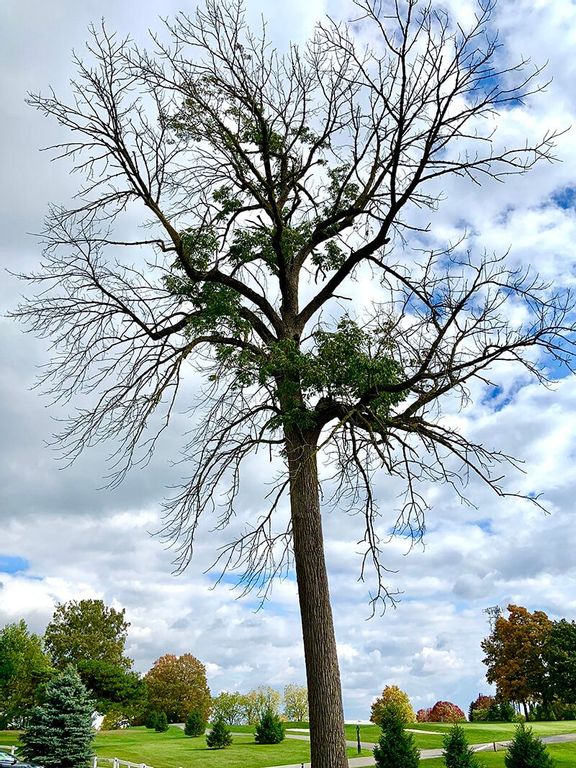
Trees in urban settings around the world are being threatened not only by climate change and habitat loss but also by noxious invasive insects, scientists say.
“Many urban areas are dominated by a single tree species or genus, which means that a newly arrived insect for which those trees are a host can spread easily. On top of this, there are usually fewer natural predators and warmer temperatures [in these areas] compared to nearby natural forests, which can benefit invasive insect development,” said Frank Koch of the USDA.
Koch is one of several authors of a paper appearing in the British Ecological Society’s Journal of Applied Ecology. The international team reported that 1.4 million street trees face destruction by invasive insects within the next three decades. Their calculations indicate that the replacement cost may exceed $900 million.

Moreover, ash trees are essential to the life cycle of wood frogs (Lithobates sylvaticus), as tadpoles readily eat fallen ash tree leaves. This diet allows the larval frogs to grow faster and bigger than with other leaf litter.
Representing USDA, Canada’s McGill University and North Carolina State University, the team conducted the very first spatial forecast of the deaths of trees caused by invasive insects, using data from 30,000 urban areas across the United States to ensure a nationwide scope.
Only one species of beetle — the emerald ash borer (Agrilus planipennis) — is expected to make ash trees go extinct. Of the 1.4 million dead trees expected, 90 percent will be killed by the emerald ash borer.
First discovered in 2002 near Detroit, the adult beetles merely nibble on ash tree leaves, causing slight damage. It is in their larval stage that they do their deadly work by feeding on the inner bark of ash trees, interrupting the tree’s ability to draw water and nutrients.

The results of the die-off are plain to see in Michigan, for example, where whole forests of dead ash trees still stand as a witness to their destruction. The beetles probably arrived in North America in solid wood packing material coming from Asia. They are found in at least 35 U.S. states and in the Canadian provinces of New Brunswick, Nova Scotia, Manitoba, Ontario and Quebec.
Adults of the species measure about 0.33 inches (8.5 millimeters) long and 0.063 inches (1.6 millimeters) wide but have a short life span after mating. Once their eggs are deposited on the bark of host trees, larvae chew their way into the inner phloem, cambium and outer xylem layers of the tree to feed and develop. By feeding, they create their characteristic, long serpentine galleries.
“We can see a similar situation in Canada…and cities like Montréal are in the process of losing all of their ash trees. Colder cities like Winnipeg appear to be seeing delayed impacts of [the] emerald ash borer due to its need to complete a longer life cycle at low temperatures,” said lead author Emma Hudgins, who earned her PhD at McGill University.

The authors of the paper believe that the destruction will not be experienced evenly: less than one quarter of communities in the United States will see 95 percent of all street tree deaths resulting from the invasive insects.
The study focused specifically on street trees, which are only a small fraction of urban trees. It forecast the economic costs imposed on cities but did not examine the ecological impact imposed by invasive insects on natural forests.
“The ecological impacts of losing urban trees or an invasive species moving from urban to natural forests would both be considerable. However, these impacts were beyond the scope of our study,” Koch said.

Among the other places of concern are Chicago, Milwaukee and New York, which have large numbers of ash trees and are in the recent path or near-future areas of destruction by the beetles. Also, because of their high human population density, these cities are expected to increase the influx of the beetles.
Moreover, there are other Asian insects of concern. For example, the citrus longhorned beetle (Anoplophora chinensis) poses a distinct threat that may impose a cost of $4.9 billion over the next 30 years.
Because urban trees are at serious risk, the researchers believe urban planners should plant multiple species in cities rather than focusing on familiar species such as ash.
“These results can hopefully provide a cautionary tale against planting a single species of tree throughout entire cities, as has been done with ash trees in North America. Increasing urban tree diversity provides resilience against pest infestations. While we know this more intuitively for monocultures of crops, many cities continue to plant what are essentially monoculture urban forests,” said Hudgins.
Ash trees may be doomed to functional extinction because affected forests show little sign of regrowth, according to Purdue University researcher Songlin Fei.
In residential areas, emerald ash beetles can be warded off by insecticides. In addition, scientists say people should buy firewood locally and not move it from place to place, in order to prevent an expansion of the beetles’ range.
Edited by Siân Speakman and Kristen Butler
Recommended from our partners
The post Invasive Insects Expected To Kill 1.4 Million Urban Trees In The US Over Next 30 Years appeared first on Zenger News.











